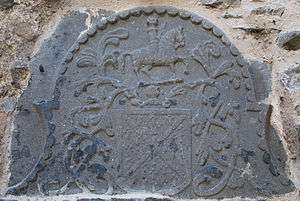More Irish than the Irish themselves
"More Irish than the Irish themselves" (Irish: Níos Gaelaí ná na Gaeil féin, Latin: Hiberniores Hibernis ipsis) is a phrase used in Irish historiography to describe a phenomenon of cultural assimilation in late medieval Norman Ireland.
History
The descendants of Hiberno-Norman lords who had settled in Ireland in the 12th century had been significantly Gaelicised by the end of the Middle Ages, forming septs and clans after the indigenous Gaelic pattern, and became known as the "Old English" (contrasting with the "New English" arriving with the Tudor conquest of Ireland).[1][2] The Statutes of Kilkenny, 1366, complained that " ... now many English of the said land, forsaking the English language, manners, mode of riding, laws and usages, live and govern themselves according to the manners, fashion, and language of the Irish enemies".[3]
The phrase (in Latin) was used by the Irish priest and historian John Lynce (c1599–1677) in his work Cambrensis Eversus.[4][5] He was strongly influenced by the writings of the historian Geoffrey Keating (1569 – c. 1644), whose History of Ireland he translated into Latin.[6] Cambrensis Eversus was translated from the Latin, with notes and observations, by Theophilus O'Flanagan, Dublin, 1795.
Eighteenth-century use
John Henry Wilson, in his Sketch of Johnathan Swift (1804), wrote that Swift used the phrase ("Hiberniores Hibernis ipsis") in a discussion with his landlord.[7]
Nineteenth-century use

The phrase remained in use by romantic nineteenth century nationalists to promote the common Irishness of 'Planter and Gael'. An example is found in the 1844 poem by the Young Irelander, Thomas Davis called 'The Geraldines', which concerns the FitzGerald dynasty:[8]
- The Geraldines
- .......
- These Geraldines! These Geraldines! -not long our air they breathed;
- Not long they fed on venison, in Irish water seethed;
- Not often had their children been by Irish mothers nursed;
- when from their full and genial hearts an Irish feeling burst!
- The English monarch strove in vain, by law, and force, and bribe,
- To win from Irish thoughts and ways this 'more than Irish' tribe;
- For still they clung to fosterage, to breitheamh, cloak and bard:
- What king dare say to Geraldine, 'Your Irish wife discard'?
- .....
Modern use
The phrase remains in common use, both colloquially and in the media, in reference to recent immigration and assimilation in Ireland, and to some degree about some of the Irish diaspora (for example in The Irish Times,[9] Senator Jim Walsh,[10] Liam Twomey,[11] or Irish Emigrant[12]) or in conversation discussing the relationship between the cultural heritage of the Irish diaspora and the Irish in Ireland.[13] While still echoing its original meaning, contemporary usage of the phrase usually takes a more open interpretation of assimilation or, in the case of the diaspora, the maintenance of Irish heritage.
Debates of the Oireachtas demonstrate the age and range of contemporary applications of the phrase. Either when discussing the diaspora:
| “ | I do not think this country will afford sufficient allurements to the citizens of other States ... The children of Irish parents born abroad are sometimes more Irish than the Irish themselves, and they would come with added experience and knowledge to our country.... | ” | |
| — Sen. Patrick Kenny, 1924 [14] | |||
Or, more light-heartedly, on assimilation:
| “ | ... [As] in olden times the attractiveness of Irish life made the Norman invaders ... 'Hiberniores Hibernicis ipsis', 'more Irish than the Irish themselves', so the charms of Galway, experienced through 25 happy years, have made a woman, born in one of the severed counties, feel entitled to describe herself as 'Galviensior Galviensibus ipsis' – 'more Galwegian than the Galwegians themselves'. | ” | |
| — Helena Concannon TD, 1937 [15] | |||
However, S. J. Connolly has written, "The descendents of the English conquerors, it was confidently proclaimed, had become 'more Irish than the Irish themselves'. Today it is recognized that the supposedly contemporary phrase dates only from the late eighteenth century, the Latin form (Hiberniores ipsis Hibernis) sometimes used to give it an authentic medieval ring from later still."[16]
See also
- More German than the Germans
- Plastic Paddy
- West Brit – a somewhat opposite expression
Notes
- ↑ MacLysaght, Edward. More Irish Families. Irish Academic Press. ISBN 0-7165-0126-0. Retrieved 20 November 2006.
Some became completely integrated, giving rise to the well known phrase 'Hiberniores Hibernis ipsis' (more Irish than the Irish themselves). These formed septs on the Gaelic-Irish pattern, headed by a chief.
- ↑ Palmer, Patricia (2001). Language and Conquest in Early Modern Ireland: English Renaissance Literature and Elizabethan Imperial Expansion. Cambridge: Cambridge University Press. p. 41. ISBN 9781139430371.
- ↑ The introduction to the text of the Statutes of Kilkenny, 1366, (pp.4–7)
- ↑ Seán O'Faoláin, The Irish (Penguin 1947), p. 59
- ↑ Kuch, Peter (2003). Irelands in the Asia-Pacific. Colin Smythe.
- ↑ Ohlmeyer, Jane (2002). Ireland from Independence to Occupation 1641–1660. Cambridge: Cambridge University Press. p. 122. ISBN 9780521522755.
- ↑ Wilson, John Henry (1804). Swiftiana Vol. 1 and 2. R. Phillips. p. 60.
- ↑ http://www.ucc.ie/celt/published/E850004-008/index.html
- ↑ LookWest. "More Irish Than the Irish Themselves?". Archived from the original on 15 July 2006. Retrieved 20 November 2006.
- ↑ "Dáil Éireann". Retrieved 20 November 2006.
- ↑ "Dáil Éireann". Retrieved 20 November 2006.
- ↑ MacConnell, Cormac. "The Pull of the City of the Tribes". Archived from the original on 27 September 2007. Retrieved 20 November 2006.
- ↑ "have you heard of this". Retrieved 20 November 2006.
- ↑ Kenny, Patrick. "Seanad Éireann – Volume 2 – 15 January 1924". Retrieved 21 November 2006.
- ↑ Concannon, Helena. "Dáil Éireann – Volume 68 – 9 June 1937". Retrieved 21 November 2006.
- ↑ Connolly, S. J. (2009). Contested Island: Ireland 1460–1630 (1st ed.). London: Oxford University Press. pp. 34–35. ISBN 9780199563715.